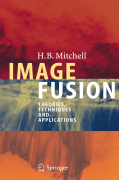
This textbook provides a comprehensive introduction to the theories, techniques and applications of image fusion. It is aimed at advanced undergraduate andfirst-year graduate students in electrical engineering and computer science. It should also be useful to practicing engineers who wish to learn the concepts of image fusion and use them in real-life applications. The book is intendedto be self-contained. No previous knowledge of image fusion is assumed, although some familiarity with elementary image processing and the basic tools of linear algebra is recommended. The book may also be used as a supplementary text for a course on advanced image processing. Apart from two preliminary chapters, the book is divided into three parts. Part I deals with the conceptual theories and ideas which underlie image fusion. Particular emphasis is given to the concept of a common representational framework and includes detailed discussions on the techniques of image registration, radiometric calibration and semantic equivalence. Part II deals with a wide range of techniques and algorithms which are in common use in image fusion. Among the topics considered are: sub-space transformations, multi-resolution analysis, wavelets, ensemble learning, bagging, boosting, color spaces, image thresholding, Markov random fields, image similarity measures and the expectation-maximization algorithm. TogetherParts I and II form an integrated and comprehensive overview of image fusion.Part III deals with applications. In it several real-life examples of image fusion are examined in detail, including panchromatic sharpening, ensemble color image segmentation and the Simultaneous Truth and Performance algorithm of Warfield et al. The book is accompanied by a webpage from which supplementary material may be obtained. This includes support for course instructors and links to relevant matlab code. Self-contained, easy accessible introduction to thehot area of image fusion Presents the most important topics in image fusion at a reasonable size Well-organized modern approach to theories and techniques,includes numerous case studies that illustrate the application of techniques for image fusion to real problems, providing hands-on knowledge Contains details of MATLAB software programs which are available for all the image fusion techniques used in the book Includes extensive modern bibliography INDICE: Image Sensors.- Part I Theories.- Spatial Alignment.- Semantic Equivalence.- Radiometric Calibration.- Pixel Fusion.- Part II Techniques.- Multi-resolution Analysis.- Image Sub-space Techniques.- Ensemble Learning.- Re-samplingMethods.- Image Thresholding.- Image Key Points.-Image SimilarityMeasures.- Vignetting,White Balancing and Automatic Gain Control Effects.- Color ImageSpaces.- Markov Random Fields.- Image Quality.- Part III Applications.- Pan-Sharpening.- Ensemble Color Image Segmentation.- STAPLE: Simultaneous Truth andPerformance Level Estimation.- Biometric Technologies.
- ISBN: 978-3-642-11215-7
- Editorial: Springer
- Encuadernacion: Cartoné
- Páginas: 200
- Fecha Publicación: 01/01/2010
- Nº Volúmenes: 1
- Idioma: Inglés
